
Lexus UX300e Review

Introduction
The UX300e is Lexus’ first attempt at an all-electric car.
Rather than make a quiet, modest entrance, the automaker is marketing this as a premium car. So forget the Kia e-Niro or the Volkswagen ID.4. According to Lexus, this is right up there with Tesla's Model 3, the Mustang Mach-E, and the Polestar 2.
Select's rating score* - 3.3 / 5
At a Glance
The asking price of over £40,000 certainly is premium, so it must be judged alongside equivalent models in that price bracket.
In terms of aesthetics, it is virtually indistinguishable from the liquid-powered UX, retaining its quirky good looks.
The car is pretty rounded, even bulbous, but has a distinctive personality and a level of attractiveness that may divide opinion. Mind you, nobody could call it boring.
It has a sharp, mean-looking front end, with V-shaped LED strips along the top of the headlights. And, as is typical of Lexus's design signature nowadays, it has that angled hour-glass grille in the middle. Then there are those two claw-like intrusions beneath the headlights running down to the fog lights.
As with some small SUVs, it appears bigger than it is, but, side-on, you can see that it is a very compact car.
The rear looks typically Japanese, with wide rear lights which taper inwards and run the entire length of the boot lid, complemented by diagonal lines.
The taillights protrude out of the bodywork towards the sides, adding a lot of personality to the rear.
Nevertheless, it is still a reasonably simple, everyday design, but Lexus says this is very much a deliberate decision. Early all-electric vehicles had a different, sort of alien-like appearance about them. You could tell they were electric purely by just looking at them. But Lexus believes that most owners will want their electric vehicles to look the same as their petrol-drinking cousins.
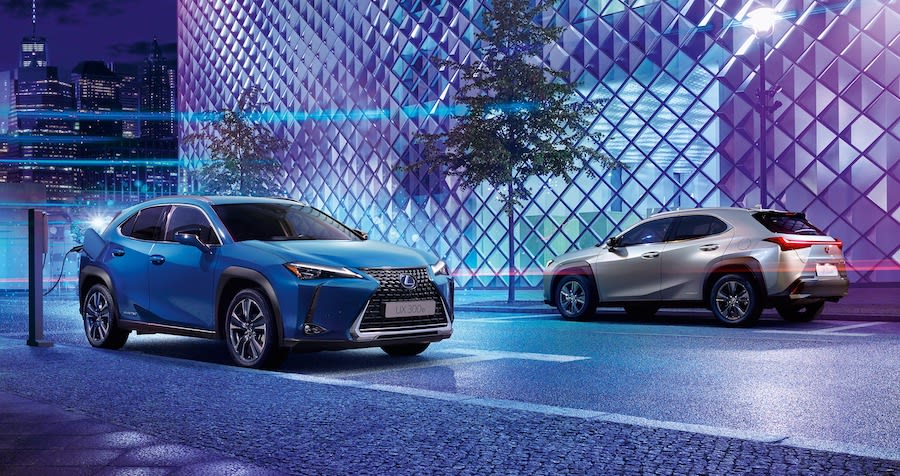
Key Features
Lexus refers to its trims as 'grades', and there are three to choose from.
The standard UX300e comes with 17-inch alloys, Lexus Safety System+, a seven-inch screen with Apple Car Play and Android Auto, a reversing camera, front and rear parking sensors, LED headlights with automatic high beam, plus electric seats.
The other couple of grades effectively add two packs of extra kit on top.
The Premium Plus Pack adds a wireless phone charger, keyless entry, a card key, heated front and rear seats, heated steering wheel and privacy glass.
The top-of-the-range Takumi Pack ups the wheels to 18-inches. It adds in SatNav on a 10.3-inch screen, a premium surround sound system, sunroof, a 360-degree view monitor, a heads-up display, a hands-free powered tailgate and blind-spot monitoring.
It all sounds awe-inspiring until you realise that you need to have the top-level trim to get SatNav. This seems a surprising omission in this day and age from what is, after all, a fairly expensive car.
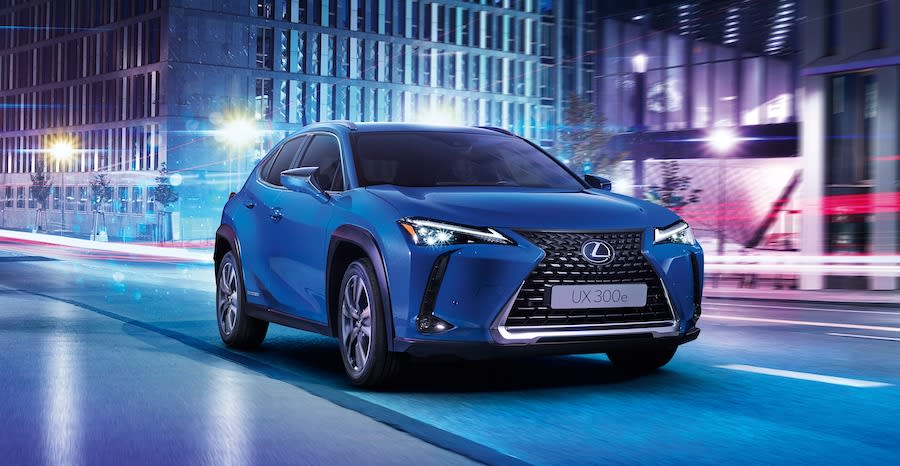
Range & Batteries
Lexus claims a range of around 200 miles on a full charge. Although when we tested it, we only got just over 150 miles on a relatively mild day.
Push it in colder, wetter conditions, with the heater on and the wipers going (which limits the range of electric vehicles), and this is likely to drop further.
By comparison, the Tesla Model 3 will do 200 miles, while the blue oval's Mustang Mach-E claims a range of over 273.
In that respect, the UX300e isn’t a car for doing long-distance motorway miles, no matter how careful you are.
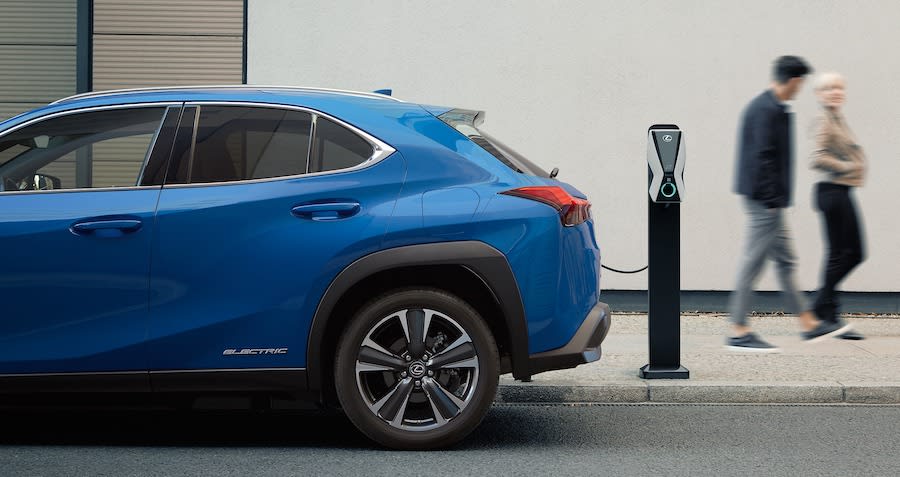
Performance & Drive
The UX300e’s electric motor is front-wheel drive and produces about 200PS.
Like many electric cars, it has lots of torque and delivers power instantly when you put your foot down on the accelerator. Therefore, moving off from the traffic lights, or driving in stop-start traffic, is dealt with quickly.
Zero to 62mph takes 7.5sec, although curiously, it feels faster than that. The top speed, though, is only 100mph and these performance figures are well behind the Tesla Model 3 and the Polestar 2.
One thing that you do notice, though, is just how relaxing the UX300e is to drive. Of course, with no engine note, it is not as loud as a standard UX. But the soundproofing from Lexus limits the volume further, with comparatively little tyre or road-noise, making for a tranquil experience.
The ride is as smooth as it is silent. It is enjoyable to drive, with the suspension ironing out lumps and bumps in the road. Lexus has clearly prioritised comfort over handling.
All those batteries beneath the floor add weight, so the structural integrity of the UX300e has been strengthened to compensate. Although the ride feels stable, preventing the car from wobbling about too much, there isn't a massive amount of grip. So, if you push it, the Lexus will understeer into corners, at which point you'll notice the body roll when you extend the steering angle further to compensate. The traction control (yes, it has that) does do an excellent job of limiting the problem, though.
There is not much feel to the steering, which is super light and effortless, but this is at the expense of any real sense that you’re turning the wheels.
Speaking of wheels, they tend to spin if you demand too much power, especially if the road conditions aren't hot and dry. And that's nearly every day in the United Kingdom.
The Japanese car will put some charge back into the batteries, too, due to energy regeneration when you lift your size-9 off the accelerator and coast. There are various brake regeneration levels that are also included, which can be selected using paddles behind the steering wheel. This means you can cut the SUV's speed progressively without touching the brakes as if you were changing down a gear as you slow to a halt at the traffic lights.
There are three driving settings – Eco, Normal and Sport – and, although there is a difference between them, with sport providing more ferocious throttle response, it doesn't transform the driving experience sufficiently to justify using it.
Likewise, there is a button to turn off the traction control. But, in all honesty, this is hardly a car with sporting credentials. So, unless you bizarrely find yourself on a racetrack, we can't think of any reason why you would need to switch it off.
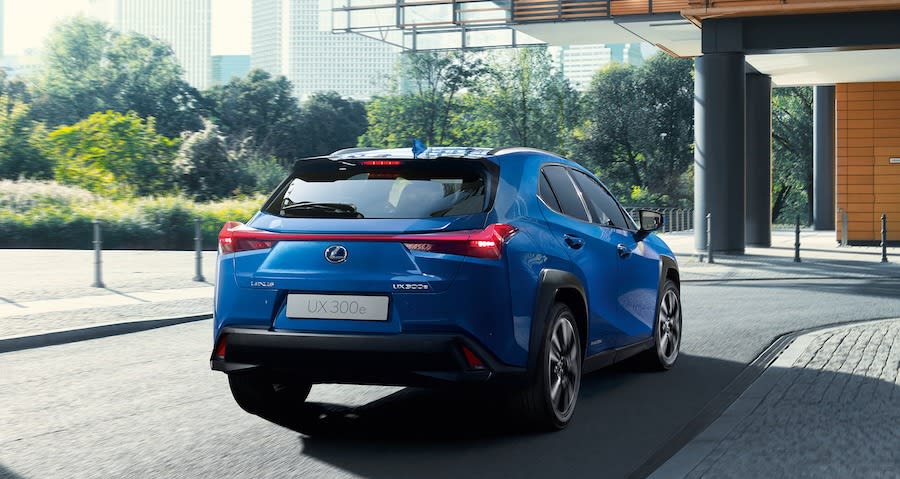
Charging
There are two charging ports on the UX300e. On the right-hand side of the car, there’s a socket for a Type 2 charger, which is for home use. This will give you a full charge from empty in around nine hours.
There is the rapid charger socket on the left-hand side of the car, which, when used, charges at around 35kW. So it will take you from 10% to 80% in approximately 75 minutes, although that's relatively slow, considering it's the fast option.
The SUV's battery has a usable capacity of about 50kWh.
It is worth noting that the UX300e uses a CHAdeMO socket for the fast charger. The majority of electric cars in the UK – and, indeed, in Europe – use a CCS socket.
Although you won’t struggle to find a CHAdeMO charger in Britain, CCS is becoming standardised. So, as more and more charging points pop up across the country, a smaller proportion of them will be compatible with the Lexus.
Running Costs & Emissions
Of course, with the ‘fuel’ being supplied from the mains, the running costs are greatly influenced by where you charge it up and the energy tariff you’re on at home, if that’s where you’re plugging it in.
Nevertheless, Lexus claims that, in terms of energy usage, the UX300e is the equivalent of around 129mpg in a traditional car, so that may help put things into perspective a bit.
Of course, it produces no CO2 emissions because there is no fossil-fuelled engine.
In terms of ongoing maintenance, service plans are offered, and, just for your information, Lexus's standard warranty is for three years up to 60,000 miles.
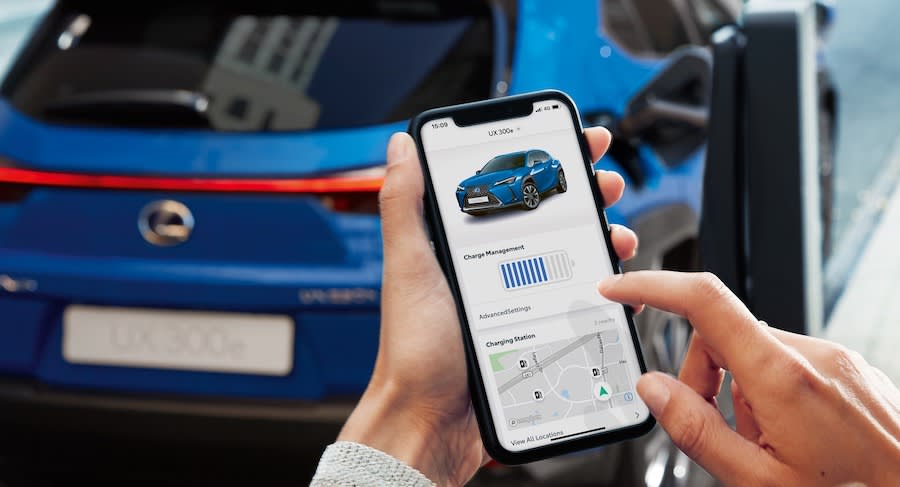
Interior & Technology
The interior is pleasant to sit in, with plenty of physical buttons. This will please those bemoaning the integration of dials and switches into a touchscreen, as seen by an increasing number of car manufacturers.
In fact, the screen in the UX300e isn't touch-sensitive at all. Instead, unusually, it is controlled by a trackpad, precisely the same as how you move the cursor on a laptop. And, it's a cursor that navigates your way around the screen. This feels very unintuitive at first, but you do get used to it. However, we can't help but feel it's adding needless complications when a rotary selector on the centre console or a touchscreen would be far more preferable.
On the plus side, the dashboard is angled, so it faces the driver, which helps you to see the infotainment screen. The system itself is not the best, though. The entry-level seven-inch screen is tiny by today's standards, and even the upgraded 10.3-inch display with the Takumi Pack isn't particularly sharp. It isn’t a user-friendly system to use, either.
Sat in the front, the sports seats are comfortable and offer a suitable driving position, albeit those who had hoped to sit higher up in an SUV will feel disappointed.
In terms of colour scheme, the interior is somewhat monotonal. A touch more brushed aluminium to break up the swathes of dark leather might have spiced things up a bit. But, overall, the cabin feels solid and well-built, and the front is certainly agreeable.
But it is a different story in the back.
Rear legroom is a particular issue – and even worse if you’re tall. The floor is higher because of the batteries underneath, so your feet and legs are in a raised position, which gets uncomfortable after a while. However, it is unlikely to be much more comfortable with a lower floor because there's no space at all to stretch your legs out, either.
Headroom is okay, but taller passengers won’t be thanking you for buying a UX300e.
A trio of adults in the rear will be a struggle, especially if they are lofty, and, even with just two shorter passengers in the back, the visibility through the rear window is limited.
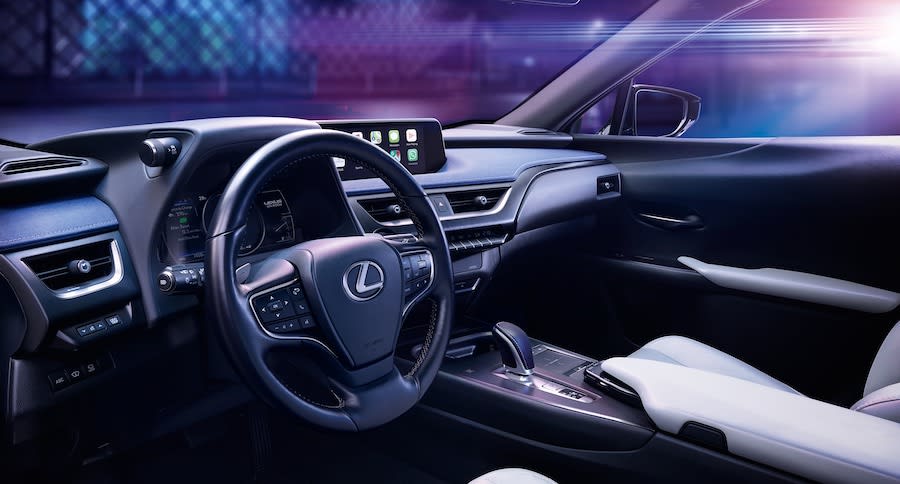
Practicality & Boot Space
The boot on the Lexus isn’t especially big, measuring in at 367-litres.
Other models, such as Tesla's Model 3, have more space, but, in truth, the cargo capacity should be more than sufficient, unless you desperately need extra room.
There is some underfloor storage, too.
In the back, there is no stowage space at all, which is odd. Apart from a flap in the back of the front seats to put a few small objects into and two cupholders found by pulling the armrest down from the middle seats, there is literally nothing else.
There are buttons in the back to control the rear heated seats if you opt for the Premium Plus Pack, though, which will amuse the children.
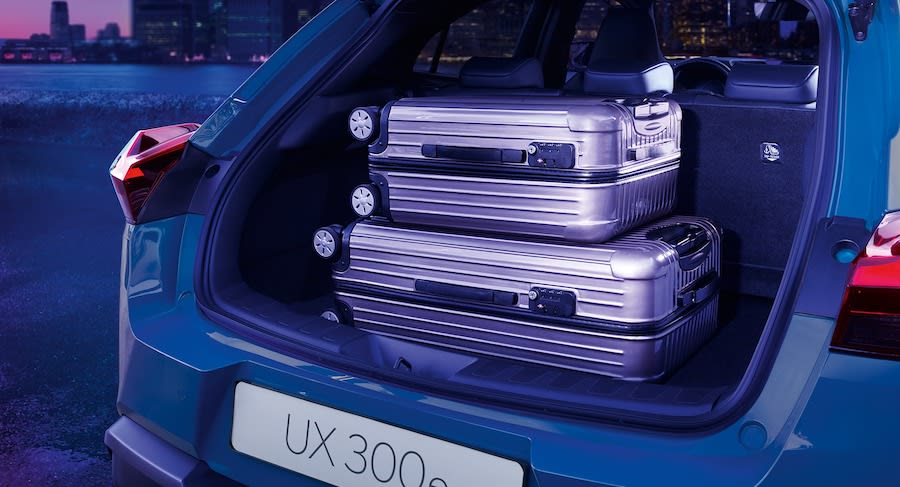
Safety
Euro NCAP crash tested the fuel-drinking version – the UX – back in 2019, awarding it a five-star safety rating.
It scored an impressive 96% for adult occupants, 85% for children and 77% for safety assists.
The car comes with the Lexus Safety System+, which adds several features, including a pre-collision system with pedestrian detection, which warns you when there is a high probability of a collision ahead.
The Lane Tracing Assist system will ensure the car stays in the correct lane on motorways and dual-carriageways. But it only works if the Dynamic Radar Cruise Control is switched on. This technology will keep you going along at a certain speed, but it will adjust automatically to ensure you remain at a fixed distance from the vehicle in front.
If you have the tech turned off for any reason, then the Lane Departure Warning system vibrates the steering wheel if it senses the vehicle is veering out of its lane.
Road Sign Assist can read the road signs, displaying them on a screen on the dashboard.
Finally, the automatic high beam will switch off by itself to avoid dazzling oncoming traffic.
Options
To some extent, the UX300e’s ‘grade’ levels provide most of the options. The fly in the ointment is that they're in 'packs', with a bunch of other things that you may not really want.
As we saw earlier, the basic trim is just called UX300e, with the next level up being the Premium Plus Pack and the range-topper being the Takumi Pack.
The problem is that if you are opting for the entry-level grade but want bigger 18-inch wheels, for example, you need to upgrade the lot to the Takumi Pack - and at a considerable cost.
As we mentioned at the top of this review, the basic car is worth over £40,000. That is a lot for a vehicle that doesn't even have SatNav. It is included, though, if you go with the Takumi Pack.
As far as actual optional extras go, the car is available in solid black or red for no extra charge. In addition - and for a price - metallic paint is offered in black, white, dark grey, light grey/titanium, red, khaki green, blue or satin silver.
Other than that, there is a chrome styling pack for the exterior, and you can get even more if you're prepared to pay for it. For instance, side sills are available, while other add-ons include a luggage box, mudguards, and a roof box.
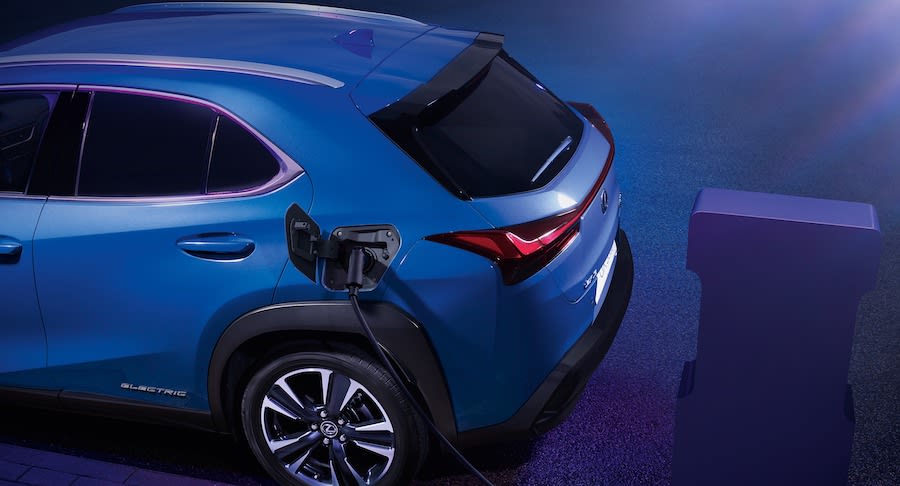
Rival Cars
We’ve mentioned a few rival cars already.
If you're thinking about the Lexus, you should also consider the Tesla Model 3, the Polestar 2, Ford's Mustang Mach-E, the Volvo XC40 Pure Electric and the Volkswagen ID.4.
All are competitively priced compared with the UX300e, while most have plusher interiors, far superior infotainment screens and are more practical. The majority should also be able to give Lexus a run for its money when it comes to build quality.
What’s more, most have better performance and a longer range.
Verdict & Next Steps
Although the silent treatment certainly suits the Lexus UX, we are not convinced that the all-electric 300e is all it’s cracked up to be.
It certainly has its good points, with likeable looks and personality. Plus, it is very smooth, relaxing, and comfortable to drive and exceptionally quiet.
But, it is being marketed as a premium product when most of its rivals beat it hands down in just about every single category. Even the likes of the Kia e-Niro is roomier and has a bigger boot.
Given the price tag, a car coming without SatNav unless you pay extra for the top of the range version feels unreasonable. And, even if you have SatNav and get the bigger screen, you are watching it in low resolution - and with a screen that's still much smaller than its rivals offer as standard.
It is a shame because there is so much to like about the UX300e, but we recommend you do some shopping around.
Sadly, it just doesn't cut the mustard when much cheaper rivals are handsomely beating it.
Where to next?
View latest Lexus UX300e leasing deals- guide price from £422.68 per month inc VAT**
Looking for a great leasing deal? Check out our incredible range of car lease deals
New electric car? Read our latest Reviews and find the right model for you
Want to know more about leasing? Take a look at our comprehensive Leasing Guides
Interested in everything motoring? Why not catch up on all the latest Car Leasing News.
*Score based on Select’s unique meta score analysis, taking into account the UK’s top five leading independent car website reviews of the Lexus UX300e
**Correct as of 01/10/2021. Based on 9 months initial payment, 5,000 miles over a 48 month lease. Initial payment equivalent to 9 monthly payments or £3,804.08 Ts and Cs apply. Credit is subject to status.





















